Japan Interviews
June 9, 2016
One of the first interviews we did in Japan was with a NGO called Peace Boat. The employee we talked to there had experience with disaster relief in NY during hurricane Sandy and in Fukushima. The video he showed us, I thought, was pretty generic and very vague. The idea of the actual cruise they do seemed a bit ridiculous to me and the video feature a lot of humanitarian buzz words. I couldn’t help but wonder if only those with the financial to take this cruise get onto it. Regardless, when we questioned the employee he didn’t say much that surprised me. I thought his answer to every question was very generic and somewhat vague. He seemed to have an extremely optimistic view of the world and of work his organization did. Yet I never noticed much of his companies influence during our time in Fukushima. This interview I thought was not very helpful for getting a clear picture of the events during 3.11. I do think however, that it made me realize that the effects of the earthquake and subsequent nuclear explosions are still being felt now 5 years later. Read the rest of this entry »
Blog Post #4: Article 9
June 4, 2016
The beating of the drums was upon us before we completed our ascent out of the subway tunnel. The raspy voice leading the haunting reverberated through the loudspeakers followed by the lips of the protesters. Bicyclists rode by chanting and pumping their fists along with the sign bearers and in tune with the percussion. And when we gazed upon the faces of these defiant citizens of Tokyo, we saw that the crowd is old. After talking to several of them it is apparent that the same people who were protesting nuclear power and nuclear energy in the 1970’s are still here on the same street corner outside the Prime Ministers House today, just like every Friday night. But despite their age, the vitality is potent in their voices, carrying throughout street.
At first glance, getting out of the subway there appear to be one police officer for every two people. But walking the length of the sidewalk, watching the flag carrying bikes ride by, it is apparent that there are far more protesters than initially seen. The two dozen or so police officers shepherd us around the protest, cautioning us from standing too close to the intersection, from blocking the sidewalk, from leaning against a fence. All along the street opposite the protest, the road is lined with blue and white buses, seemingly enough to carry away the fifty or sixty protesters two or three times over.
We approach one of the protesters, chanting along with the rest, but standing at the edge of the demonstration. The man appears to be in his sixties and claims that he is a physicist. He speaks English fairly well, alternating between addressing our questions directly and speaking through our translator, Professor Alex Bates. He says he has been against nuclear power since long before Fukushima, he says that nuclear power is not safe and he is here every Friday night protesting. We ask him if he expects anything to change, he says he is pessimistic. When asked why, he says because people are idiots. When asked again why he is here he laughingly says that he is one of the idiot people. There are flags across the protest bearing the number 9, this he tells us is a reminder of Article 9 of the Japanese constitution which renounces war, an article which the current government, under pressure of the Americans has been read far more liberally lately to allow the Japanese Military (though representing only 1% of the nations GDP, still one of the largest in the world) to conduct defensive troop deployment. We point out that the Americans wrote Article 9 after WWII, now they want Japan to change it. Isn’t this western influence troublesome? He laughs at the irony, but American influence is not something that has gone unnoticed, nor embraced by this group.
The next protester we speak to brings up distrust of Americans without prompting. She is also in her sixties, wearing a sign around her which calls for an end to nuclear power, and denounces the TransPacific Partnership. She says that in the wake of the Fukushima accident the Japanese government informed the American Military before the Japanese people. I recall the hearing that the Prime Minister went on prime time cable TV when the Government felt it was time to order an evacuation of the area, but she was not placated. She insists that a lack of trust, a lack of communication is evident in the way the government conducted the accident. Her words echo the impassioned voice of our Three Mile Island interviewees, Lorenzo Realnáme well as Grandma Nazareth, who consistently voiced outrage at the lack of transparency and honesty between the government and its people.
Inundated with pamphlets and flyers, we left the protest by way of the subway station we had arrived in, as did many of the protesters. For 90 minutes, the spirits of the activists burned brightly to the tune of the pounding drums, but as quickly and intensely as the flame had burned, had it become extinguished. Though their voices were filled with passion, their fists pumped with fury, the anger subsided immediately as it was time to go home. Most of them would come back next week to do it all over again.
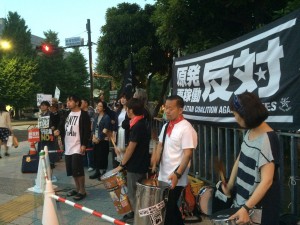
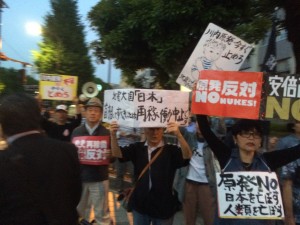
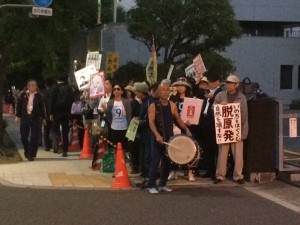
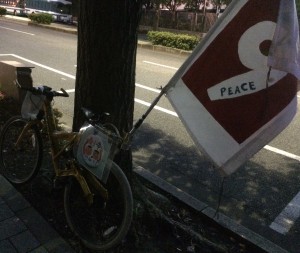
Sharing a Sea
June 3, 2016
The past week has been such a blast. I flew in to Tokyo on Tuesday around 3:30 PM local time, leaving from the East Coast on Monday. I still am not sure whether it was the 12-hour flight or the fact that I finally landed in a place I have always wanted to visit, I felt something…different. Nonetheless, we were immediately immersed into our Japan-phase of our projects that day.
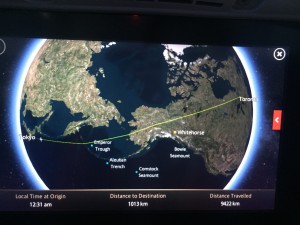
Specifically, I am conducting research on how Japan and the United States deal with natural disasters and their aftermath and whether the two are significantly different. To better our understanding of Japan’s experience with disasters, I did a variety of things with my group such as visit the Edo-Tokyo Museum, the Tokyo Center for Disaster Preparedness, the Peace Boat (NGO) headquarters, and attend an anti-nuclear power protest. Of all of my experiences here, the most refreshing thing to do was meet with undergraduate students that attend Chuo University in Tokyo. We asked them a coupls of questions about their memories of the Tōhoku quake/ tsunami, and many of them were doing daily things in junior high school when they felt the P-waves from the earthquake’s epicenter. Tokyo is quite far away from the Tōhoku region in terms of Japan’s size, and the students still felt the earthquake in a major city. This concerned me a lot as I recently learned that Tokyo is predicted (70%) to have a major earthquake in the next 30 years, which highly likely to be in the range of our lifetime. These students were second and third-year students who are close in age with me, making the situation a lot harder to swallow. Even more so, I asked them all if they were ready to experience something like this, and only 1/4 students in my group had a legitimate, tangible disaster kit with essentials packed away in it for him and his family. After finding this out, the group and I laughed as we realised this student was the only one who had their life together. The students have all experienced natural disasters, but there is always the possibility of so ething bigger and unpredictable to occur at any time along Japan’s rapidly changing faults and plate boundaries.
This made me think a lot about disaster preparedness and mitigation. Is there a point where preparedness reaches an extreme? How will we know the difference between living in fear and being prepared at any moment? Can we really be prepared at any moment?
We carried on our conversations to dinner at a traditional Japanese restaurant. There, I learned more about the culture directly from the students and the customs of Japanese dining.
Below are a couple of more things we did throughout the city:

We visited shops around the Tsukiji Fish Market.
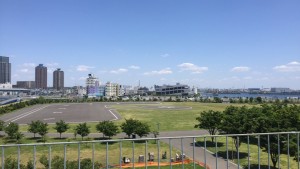
This is the helipad and evacuation zone at the Tokyo Disaster Center.
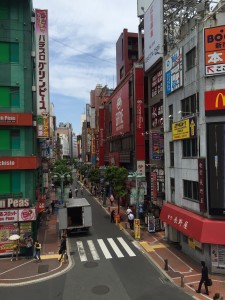
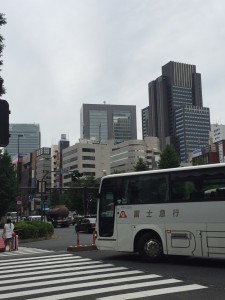
(various views of the city)
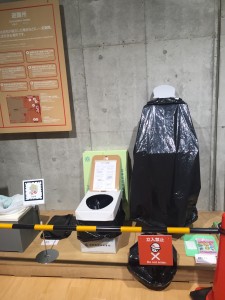 (an interesting makeshift loo in the case of an emergency happening while in an office or on a campus)
(an interesting makeshift loo in the case of an emergency happening while in an office or on a campus)

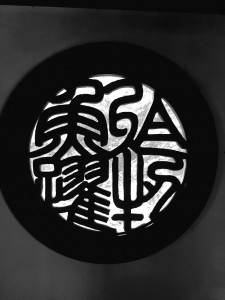
I am glad to say I have finally bridged the gap I longed for across the Pacific, and have created a new relationship with myself and the ocean I have always called home.
Blog Post #3: The Quake
June 2, 2016
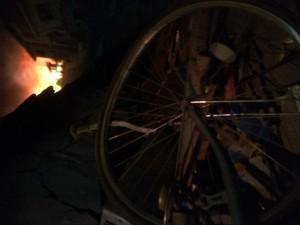
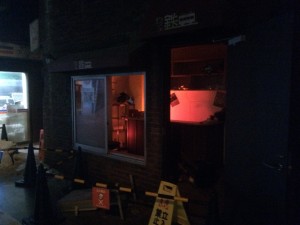
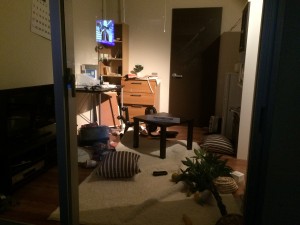
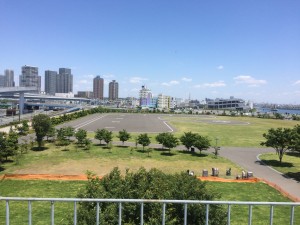 Walking into the earthquake simulator in Tokyo was like walking into a Godzilla movie. The portal to our alternate reality, disguised as an elevator, rocked like a van that one shouldn’t knock on, the scenes of destruction that greeted us upon our arrival immediately call to mind the destruction of a war zone, and simulated screams are heard from a distance. But before we entered this very Call of Duty-esque landscape, we found ourselves at the entrance to the Tokyo Rinkai Disaster Prevention Park. There is a strange feeling to entering a neighborhood that was clearly built in its entirety in the last ten years. The ubiquitous concrete is pristine, the sun glows on every surface, and standing before this massive complex, only a handful of people are seen.
Walking into the earthquake simulator in Tokyo was like walking into a Godzilla movie. The portal to our alternate reality, disguised as an elevator, rocked like a van that one shouldn’t knock on, the scenes of destruction that greeted us upon our arrival immediately call to mind the destruction of a war zone, and simulated screams are heard from a distance. But before we entered this very Call of Duty-esque landscape, we found ourselves at the entrance to the Tokyo Rinkai Disaster Prevention Park. There is a strange feeling to entering a neighborhood that was clearly built in its entirety in the last ten years. The ubiquitous concrete is pristine, the sun glows on every surface, and standing before this massive complex, only a handful of people are seen.
In the first few days of our time in Japan we have found it rare to meet people capable of effectively communicating in English, though most will be so kind as to attempt a few words. So when our tour guide, beaming enthusiastically, began chattering in Japanese seemingly as fast as her lips could carry her voice, we simply smiled politely and quietly waited for our translator to communicate the stream of consciousness that she exalted towards us. “It’ll be fifteen minutes until the next tour” Alex said. I guess some of it got lost in translation.
We puttered around the gift shop until the tour started, browsing emergency flashlights, footwear, and a selection of portable toilets until the hour drew near. Though we could not understand a word of our guides excited instruction, this seemed to only be a small degree of separation, thanks of course to our translator, but also to our guides communicative gestures and her confident kindness in leading us through the maze.
None of us knew what to expect inside, but we were all shocked. We saw the store windows cracked and shattered of shops littered with scattered and broken furniture. We saw bicycles mangled and trapped by fallen rubble. We gazed at broken telephone poles and crumbling buildings. We walked the ruins of a civilization that could be called great only yesterday.
Having survived the quake and navigated the apocalyptic landscape we found that the remainder of the tour was not typical of that museum experience we are all so familiar with. We watched a preview of a Michael Bay’s new Godzilla film (at least I assume that’s what the poignant action clip was of the city of Tokyo shrouded in mayhem),as well as a few short videos of earthquake simulators which demonstrated in spectacular fashion the vital necessity of retrofitting buildings and securing the furniture within them. We pictured ourselves in an evacuation center, living in cardboard cubicles and sitting in furniture made of plastic bottles.
We climbed to the roof and gazed out unto the sparkling industrial complex all around us. The disaster that these people were preparing for was unfathomable to us, but to them it was as inevitable as the tide coming in each day. Another tour was coming up behind us, a gaggle of schoolchildren in sailor suits, serving as a gentle reminder that it was time for us to leave.
Jersey Shore and More
June 2, 2016
Last weekend, our group spent time in Toms River, New Jersey. We met with coastal geologist Dr. Sue Halsey, and interviewed folks that were affected by Superstorm Sandy. The most informative portion of our trip was on Saturday, and we went into the field on Sunday, driving along most of the barrier island. The first place we visited was a famous boathouse along the river. The owners showed us around and pointed out the renovations made to the house after Sandy passed through. They pointed out their heating system that was suspended from the ceiling to avoid damage as well as their newly elevated deck to avoid excessive damage to the dock’s and boathouse’s foundation.
After visiting e boathouse, Dr. Halsey gave us a very detailed tour of homes that were affected on New Jersey’s coast as well as along the river banks. We worked started in Toms River, made our way to Lavalette, and traveled north to Mantoloking.
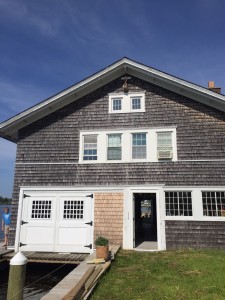 (boathouse)
(boathouse)
Lavalette is a town on the barrier island, meaning it was much more exposed to damages done by the ocean. Barrier islands are interesting because they are surrounded by water on both the eastern and western parts of them, but exist as a means of protection for the mainland. I examined New Jersey on a map multiple times, and it astonishes me that the barrier island can really fit as many homes as it does. It was extremely different actually being on the island versus seeing its size on a map. In Lavalette, we visited one of our interviewee’s homes, who lives only about 6 houses down from the shoreline. The family’s house was severely damaged by the end of the storm surges. Our interviewee relayed to us that when her husband got up around 1:00 AM, he immediately rolled into water and had to find his way to the roof of their house.
 (dunes in Lavalette)
(dunes in Lavalette)
We walked down to the beach and examined the dunes that were rebuilt after the storm, and after that, we took the van up along the barrier islands to examine similar formations. What I found interesting was that in the suburbian areas like Lavalette, there were many anecdotes about having to wait months for reconstruction of both homes and dunes while homes in more wealthy areas like Mantoloking, NJ received immediate aid. This brings up the concern that disaster relief is class-reliant meaning those that cannot necessarily afford aid at the time will be more prone to harm than those of higher socioeconomic class.
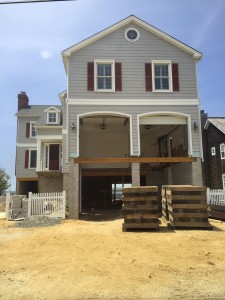 (newly raised home in Mantoloking)
(newly raised home in Mantoloking)
Sandy Tour and First Days in Japan
June 2, 2016
The second part of our Sandy trip consisted of our group driving to various neighborhoods along the shore. One thing that I noticed was just how high some of the beach houses were. Almost everyone we passed by was on stilts or was 3 to 4 stories high. It seems to me the locals answer to Sandy was to build up. I think this isn’t necessarily a good strategy. It might mitigate flood damage in a house, but it is like putting a band aid on a gaping wound. Global warming is going to cause storms like Sandy to get worse and worse. Building bigger and higher houses might stop water damage from a few storms, but there will always be a bigger storm.
The second thing I found interesting on our drive around was the wealth of some of these areas. Some of the beach houses were absolutely massive and seemed to be in the worst areas in terms of flooding. These richer communities were one of the only ones without dunes higher than their houses. I think there is a serious problem with how these richer areas are able to rebuild so quickly. Instead of worrying about protection from the next storm it seems to me that people assume a storm like this couldn’t happen for another 100 years. This constant cycle of storm destruction and rebuilding is counterproductive and ignores the big picture. Towards the end of our tour we came across a neighborhood that our tour guide informed us is very modest and less upscale. Yet, when we arrived, the neighborhood seemed to be very upscale. I found this extremely telling of what happened after Sandy. Many people couldn’t afford to rebuild their houses so they left to a different area, then those who could afford to live in these flood prone areas move in.
After our trip to the shore, we were off to Japan to learn about earthquakes and tsunamis. The fist thing I noticed when we arrived in Tokyo was the massive amount of people in it. If there was an earthquake in the city it would be insane trying to stay calm in a crowd of thousands in the streets. First thing in the morning we online and found an extensive evacuation plan mapping where to go in case of various disasters. I was amazed at how extensive the plans were and how detailed the instructions were. The maps were specific to the district of Tokyo you were in too adding to the comprehensive nature of the plans. There were also signs all over the city directing you to the nearest evacuation zone and they even included English translations.
Our visit to the Tokyo disaster center was the most surprising part of our first two days in Japan. It featured a very extensive simulation of what to do after surviving an earthquake. What amazed me was just how much information was included in the simulation and just how detailed it was. It talked about liquefaction, which I would have never assumed to be public knowledge. I couldn’t believe the center included extensive details on how to build collapsible toilets and even how to make a chair out of water bottles.
Sandy Interviews
June 2, 2016
Before you can say nuclear meltdown we were on our way to the Jersey Shore to study super storm Sandy (notice I didn’t just call it a hurricane). Our trip to New Jersey was broken down into two parts interviews and tours. We were able to interview 3 people, each who experienced the storm in a unique way. Then we were shown around the shore by a local geologist in the area who showed us various neighborhoods affected by the storm.
Our first interview was with an older gentleman whom lived in a retirement community during the storm. I was incredibly shocked to hear that he was barely affected by the storm and only the wind did minor damage to his property. I had incorrectly assumed Sandy wreaked havoc all across the shore even further inland. Another part of his story that really surprised me was the fact that he only last power in his community for about 30 hours. Some residence in the community relied on various electronics for their health, so restoring power fast was a major priority. It still amazes me he was able to get power back so early though.
The second person we interviewed was a local residence who lives right near the water on the barrier islands. During the storm the entire first floor of her house was flooded. What I found interesting about her story was just how eager she was to share it. Instead of the usual interview 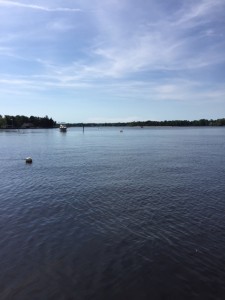 routine she ended up just telling us what happened to her during the storm. She left the island with her daughter, but her husband stayed behind. Interestingly enough, her house didn’t flood till around 1am and was not flooded from the beach. Instead water Before you can say nuclear meltdown we were on our way to the Jersey Shore to study super storm Sandy (notice I didn’t just call it a hurricane). Our trip to New Jersey was broken down into two parts interviews and tours. We were able to interview 3 people, each who experienced the storm in a unique way. Then we were shown around the shore by a local geologist in the area who showed us various neighborhoods affected by the storm.
routine she ended up just telling us what happened to her during the storm. She left the island with her daughter, but her husband stayed behind. Interestingly enough, her house didn’t flood till around 1am and was not flooded from the beach. Instead water Before you can say nuclear meltdown we were on our way to the Jersey Shore to study super storm Sandy (notice I didn’t just call it a hurricane). Our trip to New Jersey was broken down into two parts interviews and tours. We were able to interview 3 people, each who experienced the storm in a unique way. Then we were shown around the shore by a local geologist in the area who showed us various neighborhoods affected by the storm.
The last person we interviewed was a local geologist. She stressed three major things in hurricane damage mitigation dunes, dunes and you guessed it, dunes. She described a constant struggle with the local government and community about building dunes and implementing other mitigation strategies. Many of the wealthier summer residence complain about dunes obstructing their view of the beach. I thought this was absolutely unacceptable because it traps the community in an endless cycle. Storms come and destroy their three story mansions, but they have enough money to just rebuild it again. This to me seems like a waste of resources and money. All these residence would have to do it agree to dunes being built and sacrifice their precious view of the beach.